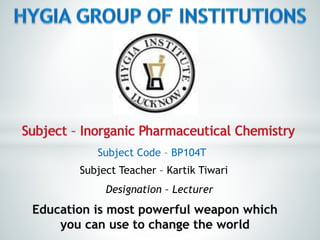
Kartik Tiwari's Lecture on Pharmaceutical Inorganic Chemistry
- 1. Subject Teacher – Kartik Tiwari Designation – Lecturer Subject Code – BP104T
- 2. “ The Right Choice for a Promising Future” The word ‘Pharmacy’ is derived from the Greek word ‘pharmakon’, meaning drug. General sense – It is a place or shop where medicines are sold. Professional sense – It is the profession, the members of which deals with drugs Pharmakon Drug The word pharmacy has two meanings :
- 4. 1. To know about the sources of impurities and methods to determine the impurities present in inorganic compounds. 2. To understand the medicinal and pharmaceutical importance of inorganic compounds. 3. To know about the preparation, properties and use of inorganic compound.
- 5. Pharmaceutical inorganic chemistry is a branch of chemistry that deals with the chemical, biochemical, pharmacological as well as their preparation and aspects of inorganic compounds. It includes study of all the elements and their compounds except carbon that are used for therapeutic purpose. Application 1. Pharmaceutical inorganic compounds are used in the treatment of gastrointestinal disorders, expectorants as well as emetics. 2. It is used in quantitative or semi-quantitative measurement of impurities present in the pharmaceutical inorganic compounds. 3. It is used in the synthesis of antacids, dental products, radio-pharmaceutical compounds etc.
- 6. UNIT - I Pharmacopoeia Pharmacopoeia is an government authorized official standard book containing a list of medicinal drugs with their effects and directions for their use.
- 7. Any unwanted foreign matter present in a compound which are differ from the actual molecular formula. Raw materials Manufacturing defects Faulty storage Adulteration Chemical instability Microbial contamination Sources of impurities
- 8. Limit test is defined as quantitative or semi- quantitative test designed to be identify and control small quantities of impurity which is likely to be present in the substance. Types of Limit test Limit test for Chlorides Limit test for Sulphate Limit test for Iron Limit test for Arsenic Limit test for Lead and Heavy metals.
- 9. Unit-II Acids An acid is any hydrogen-containing substance that is capable of donating a proton (hydrogen ion) to another substance. Examples -: Sulfuric acid, Nitric acid, Hydrochloric acid etc. Properties of Acids • Acids are corrosive in nature. • They are good conductors of electricity. • Their pH values are always less than 7. • Acids are sour in taste.
- 10. Bases A base is a molecule or ion which are able to accept a hydrogen ion from an acid. sodium hydroxide, calcium carbonate etc. Examples -: Properties of Bases • These substances release hydroxide ions (OH– ions) when dissolved in water. • In their aqueous solutions, bases act as good conductors of electricity. • The pH values corresponding to bases are always greater than 7. • Bases are bitter-tasting substances.
- 11. Buffer A buffer is a solution that can resist pH change upon the addition small amount of an acidic or basic components. Acetic acid (weak organic acid w/ formula CH3COOH) and a salt containing its conjugate base, the acetate anion (CH3COO-), such as sodium acetate (CH3COONa)
- 12. Electrolytes are minerals in your blood and other body fluids that carry an electric charge.
- 13. Dental products are those substances which prevent the dental caries, dental decay and give the freshness and cleanness to the mouth and teeth. In market it is mainly available in the form of toothpaste, tooth powder, mouthwash, tooth gel, dentifrice etc.
- 14. UNIT - III Acidifiers :- These are the agents which counteract the deficiency of acidic environment in stomach. Examples :- Dilute HCl Antacids :- Antacids are those substances which reduces gastric acidity, resulting in increase pH of stomach above 4. Example :- Calcium carbonate Gastrointestinal (GI) agents are those agents which are used in the treatment of GI disorders.
- 15. These are agents, which prevent the infection from microbes like bacteria, virus, algae, fungi etc. 1. Antibiotics agents - Those agent which is work against the bacterial infection. 2. Antifungal agents - Those agent which is work against the fungal infection. 3. Antiviral agents - Those agent which is work against the viral infection. 4. Disinfectant - These are the substance which prevents infection by complete destruction of micro-organisms.
- 16. UNIT - IV These are the agents which helps in removal of sputum from the respiratory tract that have to be expelled by coughing. On basis of mechanism of action expectorant are of two types : 1. Sedative Expectorant 2. Stimulant Expectorant Potassium Iodide Ammonium Chloride Chemical Formula - KI Chemical Formula - NH4Cl
- 17. Emetics are the agents which are administered to induced vomiting. On basis of mechanism of action vomiting induced : 1. By stimulation of chemoreceptor trigger zone. 2. By reflux producing irritation on G.I.T tract. Copper Sulphate Sodium potassium tartrate Chemical For. – CuSO4 Chemical For. – KNaC4H4O6
- 18. Haematinics are the drug that increases the amount of haemoglobin in the blood. Examples :- Ferrous Sulphate, vitamin B12, and iron Its generally iron/ferrous containing compounds which are used in the treatment of iron deficiency anaemia for the formation of blood by the process of hematopoiesis.
- 19. An antidote is a substance that can counteract a form of poisoning. An poison is a substance( Solid, Liquid, Gas) that when introduce into or absorbed by a living organism cause serious illness or death.
- 20. Astringent are those agents which precipitate the protein if they applied to the protein containing surface. Astringent is a drug that react Chemically with cellular proteins producing limited coagulation which is accompanied with shrinkage of body tissues. Astringent protects from external irritation and reduces cellular permeability. It also possesses local styptic and local antiseptic actions.
- 21. UNIT - V Radiopharmaceuticals are the pharmaceutical formulation consisting of radioactive substances, which are intended for use either in diagnosis or therapy.
